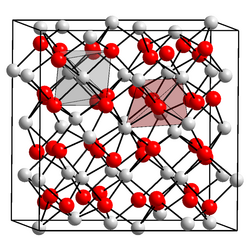 | |
| Names | |
|---|---|
| Other names Americium sesquioxide | |
| Identifiers | |
3D model (JSmol) | |
| |
| |
| Properties | |
| Am2O3 | |
| Molar mass | 534 g·mol−1 |
| Density | 11.77 |
| Melting point | 2,205 °C (4,001 °F; 2,478 K) |
| Structure | |
| Trigonal, hP5 | |
| P3m1, No. 164 | |
| Related compounds | |
Other cations | Curium(III) oxide |
Related compounds | Americium dioxide Americium(II) oxide |
Except where otherwise noted, data are given for materials in their standard state (at 25 °C [77 °F], 100 kPa). | |
Americium(III) oxide or americium sesquioxide is an oxide of the element americium. It has the empirical formula Am2O3. Since all isotopes of americium are only artificially produced, americium (III) oxide has no natural occurrence. The colour depends on the crystal structure, of which there are more than one. It is soluble in acids. [2]